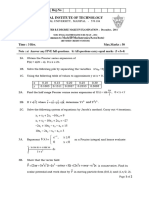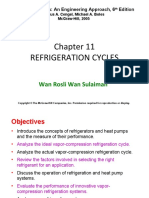0 ratings0% found this document useful (0 votes)
13 viewsFinal Exam of Numerical Analysis 2-JANUARY-2013 (3 HOURS)
Final Exam of Numerical Analysis 2-JANUARY-2013 (3 HOURS)
Uploaded by
MohammedThe document outlines a 3 hour final exam for a Numerical Analysis course consisting of 3 questions worth a total of 70 points. Question 1 involves using fixed point and Jacobian methods to solve equations and systems of equations. Question 2 focuses on interpolation, asking students to write formulas, construct divided difference tables, and use Newton's forward interpolation method. Question 3 covers integration rules, asking students to use Trapezoidal and Simpson's rules to estimate definite integrals and find errors.
Copyright:
© All Rights Reserved
Available Formats
Download as PDF, TXT or read online from Scribd
Final Exam of Numerical Analysis 2-JANUARY-2013 (3 HOURS)
Final Exam of Numerical Analysis 2-JANUARY-2013 (3 HOURS)
Uploaded by
Mohammed0 ratings0% found this document useful (0 votes)
13 views1 pageThe document outlines a 3 hour final exam for a Numerical Analysis course consisting of 3 questions worth a total of 70 points. Question 1 involves using fixed point and Jacobian methods to solve equations and systems of equations. Question 2 focuses on interpolation, asking students to write formulas, construct divided difference tables, and use Newton's forward interpolation method. Question 3 covers integration rules, asking students to use Trapezoidal and Simpson's rules to estimate definite integrals and find errors.
Original Title
Model3
Copyright
© © All Rights Reserved
Available Formats
PDF, TXT or read online from Scribd
Share this document
Did you find this document useful?
Is this content inappropriate?
The document outlines a 3 hour final exam for a Numerical Analysis course consisting of 3 questions worth a total of 70 points. Question 1 involves using fixed point and Jacobian methods to solve equations and systems of equations. Question 2 focuses on interpolation, asking students to write formulas, construct divided difference tables, and use Newton's forward interpolation method. Question 3 covers integration rules, asking students to use Trapezoidal and Simpson's rules to estimate definite integrals and find errors.
Copyright:
© All Rights Reserved
Available Formats
Download as PDF, TXT or read online from Scribd
Download as pdf or txt
0 ratings0% found this document useful (0 votes)
13 views1 pageFinal Exam of Numerical Analysis 2-JANUARY-2013 (3 HOURS)
Final Exam of Numerical Analysis 2-JANUARY-2013 (3 HOURS)
Uploaded by
MohammedThe document outlines a 3 hour final exam for a Numerical Analysis course consisting of 3 questions worth a total of 70 points. Question 1 involves using fixed point and Jacobian methods to solve equations and systems of equations. Question 2 focuses on interpolation, asking students to write formulas, construct divided difference tables, and use Newton's forward interpolation method. Question 3 covers integration rules, asking students to use Trapezoidal and Simpson's rules to estimate definite integrals and find errors.
Copyright:
© All Rights Reserved
Available Formats
Download as PDF, TXT or read online from Scribd
Download as pdf or txt
You are on page 1of 1
FINAL EXAM OF NUMERICAL ANALYSIS
2-JANUARY-2013 (3 HOURS)
Question 1: [20 Points]
a: Use the Fixed- point method with (7) iteration steps
and (5) decimal places to approximate the root x of:
x − sin x = 0, x0 = 0.1
b: Solve the following system taken: X0 = [0, 0, 0]T :
10x1 −x2 −3x3 = 1, x1 +10x2 −2x3 = 0, 3x1 +2x2 +10x3 = −2.
Using (1) Jacobian method. (2) LU decomposition method.
Question 2: [25 Points]
b: Write the General formula of Lagrange interpolation
method for x0 , x1 , x2 , x3 .
a: Given the data in the following table:
x 0 0.5 1 1.5 2
f (x) 6 10 12 9 4
(1) Construct the table of divided difference Newton.
(2) Use Newton forward interpolation method to ap-
proximate f (0.2), f (1.2) and use it to approximate
0
f (x) for each x.
Question 3: [25 Points]
Z x
dx
a: Let: ln x = · Use the Trapezoidal rule to approximate
1 x
(ln 2), taken (h = 0.2) and find the absolute error.
1
b: Prove that the simple Simpson’s rule written as:
3
Z x2
h
f (x)dx = [f0 + 4f1 + f2 ].
x0 3
Z π
1 4 x
c: Use the ( ) complex Simpson’s rule to estimate dx
3 0 cos x
and find the maximum error |Emax |, minimum error |Emin |.
Dr. Yaser Alhuri
You might also like
- Extracredit PDFDocument337 pagesExtracredit PDFMohammed100% (2)
- Chapter 2 PDFDocument3 pagesChapter 2 PDFMakobela MmakwenaNo ratings yet
- TS 2 - 012434Document2 pagesTS 2 - 012434KAPEMBWA MAPALONo ratings yet
- Tut 7Document2 pagesTut 7DheerajSolletiNo ratings yet
- 2018 Summer Question PaperDocument4 pages2018 Summer Question Paperriteshkadam4050No ratings yet
- Roll No. ...................... Total Pages: 3: GSM/D-21Document3 pagesRoll No. ...................... Total Pages: 3: GSM/D-21Pankaj KaushikNo ratings yet
- Assignment4 PDFDocument2 pagesAssignment4 PDFVijay VijayNo ratings yet
- SMA1116 Tutorial Worksheet 1Document3 pagesSMA1116 Tutorial Worksheet 1tavongajchinhenzvaNo ratings yet
- Lecture 05: Applications of MATLABDocument80 pagesLecture 05: Applications of MATLABBirhex FeyeNo ratings yet
- Numerical Methods QBDocument4 pagesNumerical Methods QBNarmatha ParthasarathyNo ratings yet
- Problems Set On Numerical MethodDocument4 pagesProblems Set On Numerical Methodanuragsisodiya2121No ratings yet
- Conm 2021Document3 pagesConm 2021vanshikasharma2701No ratings yet
- Engineering Mathematics III (MAT - 201) RCS (Makeup)Document2 pagesEngineering Mathematics III (MAT - 201) RCS (Makeup)dreamivory29No ratings yet
- Hello WorldDocument3 pagesHello WorldBimal Kumar SahooNo ratings yet
- Tutorial Cal 2Document3 pagesTutorial Cal 2sara johnNo ratings yet
- 1011sem1 Ma2213Document4 pages1011sem1 Ma2213jlee970125No ratings yet
- TALLER N°1 Preliminares - RepasoCalculo (I) 2022 02 UCDocument2 pagesTALLER N°1 Preliminares - RepasoCalculo (I) 2022 02 UCjgg344862No ratings yet
- Math Tutorial SheetDocument3 pagesMath Tutorial SheetKondwani BandaNo ratings yet
- MA204 2024 SM Tutoril 1Document2 pagesMA204 2024 SM Tutoril 1Roshan SainiNo ratings yet
- Cal1 TD2 (2023 24)Document2 pagesCal1 TD2 (2023 24)Da VyNo ratings yet
- 1653 List 10 AnswersDocument5 pages1653 List 10 Answerscs17plNo ratings yet
- Calculus Excercises Derivative and ApplicationsDocument4 pagesCalculus Excercises Derivative and ApplicationsVan Anh PhamNo ratings yet
- Calculus Midterm Practice 1Document2 pagesCalculus Midterm Practice 1Lucas ZaccagniniNo ratings yet
- Question Bank 1711435538Document10 pagesQuestion Bank 1711435538VANSH BHATINo ratings yet
- Class 12 Question PaperzDocument2 pagesClass 12 Question PaperzSohail150788No ratings yet
- MTL107 Set 8Document5 pagesMTL107 Set 8M.Y M.ANo ratings yet
- Calculus Test12 Sol 20191015Document7 pagesCalculus Test12 Sol 20191015Mạc Hải LongNo ratings yet
- Question Bank-Mam581-2017 FinalDocument6 pagesQuestion Bank-Mam581-2017 FinalRohit DiwakarNo ratings yet
- Tutorial Worksheet 2Document3 pagesTutorial Worksheet 2Manex ManNo ratings yet
- Practice Problems IiDocument3 pagesPractice Problems IiHelloNo ratings yet
- MATLAB File UMA021-3Document17 pagesMATLAB File UMA021-3Aksh KhuranaNo ratings yet
- С.2 Derivative - HW - 2Document1 pageС.2 Derivative - HW - 2PashaNo ratings yet
- Screenshot 2023-05-29 at 7.36.54 PMDocument8 pagesScreenshot 2023-05-29 at 7.36.54 PMAshish KumarNo ratings yet
- PS1ADocument1 pagePS1ARdmstNo ratings yet
- PQ1 Seng 101Document3 pagesPQ1 Seng 101SMG Lil FlippNo ratings yet
- maths-class-xi-limits-derivatives-practice-paper-01Document2 pagesmaths-class-xi-limits-derivatives-practice-paper-01tusharNo ratings yet
- Sol5 WrittenDocument12 pagesSol5 WrittenLeewin 26No ratings yet
- Question Bank (2014) MAM-581, Engineering Mathematics V: Unit#2 16Document7 pagesQuestion Bank (2014) MAM-581, Engineering Mathematics V: Unit#2 16ashutoshNo ratings yet
- Assignment 1Document3 pagesAssignment 1Ronan CarrollNo ratings yet
- C43 - Integrals - Part 3Document26 pagesC43 - Integrals - Part 3caokhuong12311No ratings yet
- LCD 13Document4 pagesLCD 13Anusha SinghalNo ratings yet
- Trabajo 1Document8 pagesTrabajo 1jhonNo ratings yet
- Numerical Methods: F D F D DF F FDocument2 pagesNumerical Methods: F D F D DF F FLipika SurNo ratings yet
- Chapter 12-b: Integral Calculus - ExtraDocument24 pagesChapter 12-b: Integral Calculus - ExtraShahnaz GazalNo ratings yet
- TALLER #1 Preliminares Repaso de CálculoDocument3 pagesTALLER #1 Preliminares Repaso de CálculoJOAN SEBASTIAN DIAZ OCAMPONo ratings yet
- Problemas de Cálculo I (Enunciados)Document10 pagesProblemas de Cálculo I (Enunciados)Miguel Ángel Acebo VisanzayNo ratings yet
- Calculus of Single Variable I 2022 AprilDocument3 pagesCalculus of Single Variable I 2022 Aprilrukkiya253No ratings yet
- Estimation of Roots of EquationsDocument18 pagesEstimation of Roots of EquationsannexarikodiNo ratings yet
- Assignment 2Document2 pagesAssignment 2Lokesh Kumar GuptaNo ratings yet
- Numerical IntegrationDocument17 pagesNumerical IntegrationAlexis Bryan RiveraNo ratings yet
- Numerical Integration PDFDocument17 pagesNumerical Integration PDFMikhail TabucalNo ratings yet
- Tutorial 2Document2 pagesTutorial 2Mayssem MoussaNo ratings yet
- Assignment NumericalDocument3 pagesAssignment NumericalRahul KumarNo ratings yet
- Assignment2100916 17 FirstDocument4 pagesAssignment2100916 17 FirstAneesh JatarNo ratings yet
- 3 SolDocument3 pages3 SolnamanNo ratings yet
- Math For Economics Assignment - 1Document4 pagesMath For Economics Assignment - 1geraldayh98No ratings yet
- Problem sheet 5: x→0 x x→2 x −3 +1 x−sin πxDocument1 pageProblem sheet 5: x→0 x x→2 x −3 +1 x−sin πxTunyi AmadeoNo ratings yet
- 2 3 OHTAStudentDocument14 pages2 3 OHTAStudentPame CorralNo ratings yet
- 1 Tan 6 6 Cos) Lim) Lim Cos) Lim 3 2 1 1 Sin (7) 3 3 5 1) Lim) Lim) Lim 4 2 10 6 10 2 1 1, 3 2 3 3) Lim ?) Lim 12 2, 3 3 2 1 1 Co) Lim) Lim 2 S SinDocument3 pages1 Tan 6 6 Cos) Lim) Lim Cos) Lim 3 2 1 1 Sin (7) 3 3 5 1) Lim) Lim) Lim 4 2 10 6 10 2 1 1, 3 2 3 3) Lim ?) Lim 12 2, 3 3 2 1 1 Co) Lim) Lim 2 S SinEng-Mukhtaar CatooshNo ratings yet
- IMP QuestionsDocument3 pagesIMP Questionsthakursurbhi2005No ratings yet
- Ice 1Document74 pagesIce 1MohammedNo ratings yet
- كوز تحسينDocument1 pageكوز تحسينMohammedNo ratings yet
- قياسات م8 PDFDocument4 pagesقياسات م8 PDFMohammedNo ratings yet
- رياضة الدكتور م5Document3 pagesرياضة الدكتور م5MohammedNo ratings yet
- ياسر الحوري الثانيةDocument2 pagesياسر الحوري الثانيةMohammedNo ratings yet
- انور الثانيةDocument4 pagesانور الثانيةMohammedNo ratings yet
- Problem - Correlation - Guide 7 PDFDocument3 pagesProblem - Correlation - Guide 7 PDFMohammedNo ratings yet
- Chap11 - EFM Problem LogDocument3 pagesChap11 - EFM Problem LogMohammedNo ratings yet
- 9th Ed 8th Ed Comment Chap7 - EFM Problem LogDocument3 pages9th Ed 8th Ed Comment Chap7 - EFM Problem LogMohammedNo ratings yet
- Outline and Equation Sheet For M E 345: Every Additive Term in An Equation Must Have The Same DimensionsDocument7 pagesOutline and Equation Sheet For M E 345: Every Additive Term in An Equation Must Have The Same DimensionsMohammedNo ratings yet
- Refrigeration Cycles: Wan Rosli Wan SulaimanDocument18 pagesRefrigeration Cycles: Wan Rosli Wan SulaimanMohammedNo ratings yet
- 1 Second LowDocument22 pages1 Second LowMohammedNo ratings yet
- Errors and Calibration: Random vs. Systematic ErrorsDocument4 pagesErrors and Calibration: Random vs. Systematic ErrorsMohammedNo ratings yet
- Final Exam May12 SolutionsDocument9 pagesFinal Exam May12 SolutionsMohammedNo ratings yet
- Report of Measuring WheelDocument9 pagesReport of Measuring WheelMohammedNo ratings yet
- Problem - Correlation - Guide 2Document4 pagesProblem - Correlation - Guide 2MohammedNo ratings yet
- Img 20200829 053051 417Document18 pagesImg 20200829 053051 417MohammedNo ratings yet
- Valves in Piping ReadyDocument18 pagesValves in Piping ReadyMohammedNo ratings yet














































































